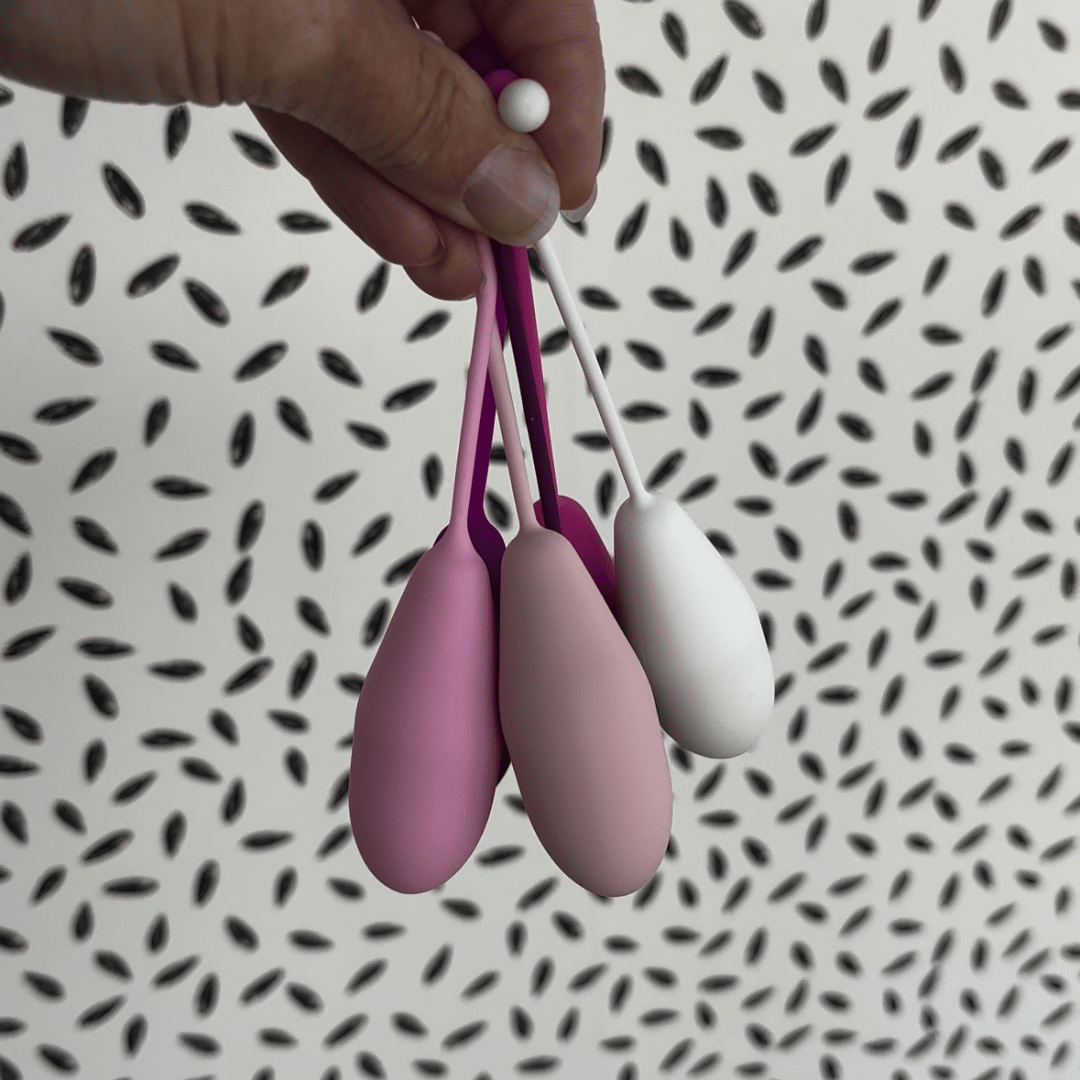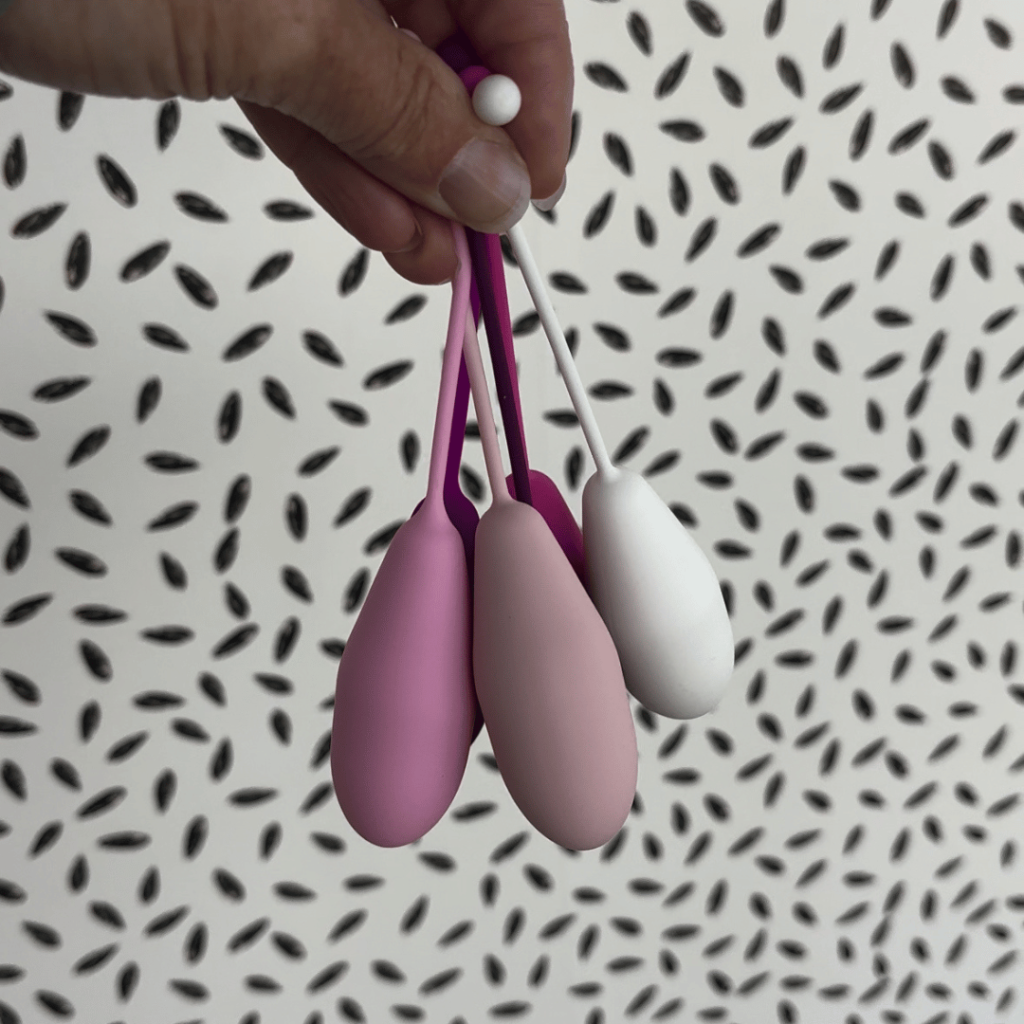So, What Are Kegel Weights Exactly?
Kegel weights were originally developed to provide a more effective and engaging way to perform pelvic floor muscle training. Think of them is as dumbbells for your pelvic floor muscles! Kegel weights, also known as vaginal weights, pelvic floor weights, and vaginal cones come in various shapes and sizes, typically resembling small balls or cones. Ideally, they are made from body-safe materials like silicone or plastic and often come in varying colour-coded sets. Kegel weights are used progressively, starting with a lighter weight and gradually moving to heavier ones as the pelvic floor muscles become stronger.
Kegel weights are inserted into the vagina. Once inserted, the user relies on their pelvic muscles to keep the weight in place during activity. They can be used in various positions, from lying to sitting and standing; progressing from easier to more difficult positions. We want to remind you that these handy conditioning devices are are to be used for your exercises only. Once your exercises are completed, the weight is to be removed. Do not leave Kegel weights in all day. The result? With regular use, stronger pelvic floor muscles. Stronger pelvic floor muscles can be helpful in reducing issues relating to urinary incontinence, pelvic organ prolapse and sexual health. More on that below!
Before we continue…
This post, written from a physiotherapy perspective, aims to be informative for both allied health professionals and individuals interested in learning more about Kegel weights.
Why Kegel Weights?
Before we dive into the details about Kegel weights, let’s start at the beginning: pelvic floor muscle training.
Traditional Kegel exercises are a method of pelvic floor muscle training designed to help individuals strengthen and tone their pelvic floor muscles. While Kegels can be beneficial on their own, they sometimes lack the sensory feedback necessary for individuals to properly engage their pelvic floor muscles (Herbison & Dean, 2013). This renders the exercise ineffective.
Enter, Kegel weights. Kegel weights provide this feedback, making it easier for users to identify and properly contract their muscles during exercises (Cho & Kim, 2021). These small, weighted devices are designed to be inserted into the vagina to aid in strengthening and retraining the pelvic floor muscles, helping individuals recognize and control their pelvic floor more effectively (Herbison & Dean, 2013).
The Pelvic Floor Recap
As Cho & Kim (2021) explain, the pelvic floor is a group of muscles that forms a hammock-like structure at the base of the pelvis. It stretches from the pubic bone at the front to the tailbone at the back and from one sitting bone to the other. These muscles support the pelvic organs, including the bladder, uterus (or prostate in males), and rectum. They also help control bowel and bladder functions and play an important role in sexual function. Keeping the pelvic floor muscles strong and coordinated can alleviate a range of conditions and improve overall pelvic health.
Bonus Benefits of Kegel Weight Training
Improved Muscle Awareness
Kegel weights can help individuals better recognize and control their pelvic floor muscles. The sensation of the weight inside the vagina provides immediate feedback, prompting the muscles to contract and hold the weight in place. This awareness is invaluable for performing pelvic floor exercises correctly and effectively.
Enhanced Exercise Adherence
Raise your hand if you need help remembering to do your Kegels?! You’re not alone! As with any exercise routine, maintaining consistency can be challenging. Kegel weights add a “tangible element” (Cho & Kim, 2021) to the exercises, making them more engaging and easier to remember.
Effective Resistance Training
Like any other muscle group, the pelvic floor muscles benefit from resistance training. Kegel weights act as resistance, making the exercises more challenging. As you progress, you can gradually increase your weight, building the strength and endurance in your pelvic floor muscles.
Benefits of Using Kegel Weights
Enhanced Sexual Health
Stronger pelvic floor muscles can enhance sexual sensation and satisfaction by increasing vaginal tone and blood flow to the area. This can lead to more pleasurable experiences during intercourse and more intense orgasms. The resistance provided by Kegel weights helps achieve these benefits may be more effective in strengthening the pelvic floor than Kegel exercises alone.
Improved Bladder Control
Kegel weights can significantly improve conditions like stress incontinence (leakage during activities like coughing or lifting) and urge incontinence (a sudden, intense urge to urinate). Strengthening the pelvic floor muscles with weights can help regain bladder control and reduce the frequency and severity of leaks.
Postpartum Recovery
After childbirth, pelvic floor muscles can be stretched and weakened. As a result, 1 in 3 postpartum individuals experience involuntary bladder leakage (Herbison & Dean, 2013). Using Kegel weights can help new mothers regain muscle strength and improve bladder control. Early intervention with Kegel weights can support a smoother postpartum recovery and prevent long-term pelvic floor issues.
Preventing Pelvic Organ Prolapse
Regular use of Kegel weights can help prevent pelvic organ prolapse, where pelvic organs descend due to weakened support structures. Strengthening the pelvic floor muscles can provide better support for the pelvic organs and reduce the risk of prolapse. In addition, they can also be used as a treatment for mild presentations of Pelvic Organ Prolapse.
How to Use Kegel Weights
Using Kegel weights might feel intimidating but, really, it’s just a few simple steps. That said, following the steps carefully is important to avoid injury or discomfort. We strongly recommend using these tools under the guidance of a pelvic floor physiotherapist rather than on your own.
Prioritize Cleanliness
Before inserting your Kegel weight, ensure that you thoroughly wash your hands and the weight you intend to use, thoroughly with a fragrance-free soap and warm water or a menstrual cup cleanser.
Choose the Right Kegel Weight
Begin with the lightest weight in the set. As your muscles strengthen, you can gradually move to heavier weights.
Insertion
Apply a small amount of water-based lubricant to the weight. Insert it into the vagina in a comfortable, standing or lying down position, similar to inserting a tampon.
Engage Your Muscles
Once the weight is in place, contract your pelvic floor muscles to hold it inside. You should feel your muscles lifting the weight.
Exercise Routine
Exercise routines will be unique based on the individual’s condition and lifestyle. A general routine will begin with short sessions, around 5 minutes, once or twice a day. Gradually increase the duration as your muscles get stronger. Aim for up to 15-20 minutes per session (Herbison & Dean, 2013).
When integrating Kegel weights into your pelvic floor muscle training, it’s important to vary your exercise positions and the speed of contractions to make your routine more dynamic.
Remove and Clean
After your session, remove the weight gently. Clean it with mild soap and warm water, and dry it thoroughly before storing.
For more, check out this excellent instructional video here:
Tips for Effective Use
Consistency is Key
Regular use is essential for seeing results. Try to incorporate the exercises into your daily routine.
Listen to Your Body
If you experience pain or discomfort, stop using the weights and consult with a healthcare professional.
Combine with Other Exercises/Physical Therapies
Incorporating other pelvic floor exercises, such as traditional Kegels without weights, can enhance the strengthening effect.
Stay Relaxed
Sometimes this one is easier said than done! Avoid tensing other muscles (like the abdomen or bum) while doing the exercises. Focus on isolating the pelvic floor muscles.
Are Kegel Weights for All Pelvic Floor Conditions?
Kegel weights are beneficial for many pelvic floor conditions, yet it’s important to note that they may not be suitable for everyone. Some conditions may be worsened by their use. These include:
Active Infections
Using Kegel weights during an active pelvic infection could exacerbate symptoms or hinder healing.
Recent Pelvic Surgery
Immediately after pelvic surgery, including procedures like a hysterectomy or repair of pelvic organ prolapse, Kegel weights might not be recommended until healing progresses.
Severe Pelvic Pain
Conditions causing severe pelvic pain, such as acute pelvic inflammatory disease or severe endometriosis, may not benefit from Kegel weights until pain is adequately managed.
Uncontrolled Pelvic Floor Spasms
In cases of hypertonic pelvic floor dysfunction where the muscles are overly tense and spasming, Kegel weights could potentially worsen symptoms. If you are experiencing persistent low back or hip pain, please do not use Kegel weights until you have been assessed by a pelvic floor physiotherapist.
Pelvic Organ Prolapse (in certain cases)
While Kegel exercises are often recommended for mild to moderate pelvic organ prolapse, severe cases may require more specialized interventions.
It is vital to consult with a healthcare provider or pelvic floor physiotherapist before starting any pelvic floor exercise regimen, including the use of Kegel weights, to ensure they are appropriate for your specific condition and needs.
Wrapping Up
Kegel weights, developed as a supplementary treatment to traditional pelvic floor muscle exercises, offer an effective and engaging way to strengthen these key muscles. By providing immediate feedback, enhancing exercise adherence, and acting as a form of resistance training, Kegel weights can help individuals achieve better outcomes in pelvic floor health and overall well-being.
You can shop one of our favourite sets of Kegel weights here. To receive personalized guidance and support regarding Kegel weights, please book an assessment with one of our pelvic floor physiotherapists here.
Bump Physio & Co is a community of health care providers dedicated to changing the way pelvic health and obstetrical services are delivered. Our two clinics locations are Port Moody and Langley BC, where we treat beyond the Bump and welcome clients from all stages and phases of life. Our team has advanced training in Pelvic Health, Orthopedics, Obstetrics, Clinical Pilates, and Active Rehabilitation.
Want to tap into all the pelvic floor expertise the Bump Community has to offer? Follow us on our socials! @bumpphysio.co
Citations
Herbison, G. P., & Dean, N. (2013). Weighted vaginal cones for urinary incontinence. The Cochrane database of systematic reviews, 2013(7), CD002114. https://doi.org/10.1002/14651858.CD002114.pub2
Retrieved from:
https://www.ncbi.nlm.nih.gov/pmc/articles/PMC7086390
Cho, S. T., & Kim, K. H. (2021). Pelvic floor muscle exercise and training for coping with urinary incontinence. Journal of Exercise Rehabilitation, 17(6), 379-387.
Retrieved from:


